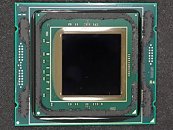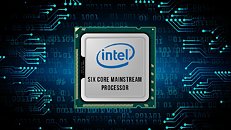Friday, September 22nd 2017

Intel Core i7 8700K Reportedly Reaches 4.8 GHz Easily, 5 GHz+ Requires Delid
A report out of Expreview says that users should expect Intel's 8700K 6-core processor to easily clock up to 4.8 GHz with conventional cooling methods. Apparently, the chip doesn't even need that much voltage to achieve this feat either; however, thermal constraints are quickly hit when pushing Intel's latest (upcoming) leader for the mainstream desktop parts. Expreview says that due to the much increased temperatures, users who want to eke out the most performance from their CPU purchase will likely have to try and resort to delidding of their 8700K. While that likely wouldn't have been necessary with Intel's 7700K processors, remember that here we have two extra CPU cores drawing power and producing waste heat, so it makes sense that thermals will be a bigger problem.
This is understandable: Intel is still using their much chagrined (and divisive) TIM as a heat conductor between the CPU die and the CPU's IHS (Integrated Heat Spreader), which has been proven to be a less than adequate way of conducting said heat. However, we all knew this would be the case; remember that Intel's HEDT HCC processors also feature this TIM, and in that case, we're talking of up to 18-core processors that can cost up to $1,999 - if Intel couldn't be bothered to spend the extra cents for actual solder as an interface material there, they certainly wouldn't do so here. As with almost all peeks at as of yet unreleased products, take this report (particularly when it comes to frequencies, as each CPU overclocks differently) with a grain of salt, please.
Source:
Expreview
This is understandable: Intel is still using their much chagrined (and divisive) TIM as a heat conductor between the CPU die and the CPU's IHS (Integrated Heat Spreader), which has been proven to be a less than adequate way of conducting said heat. However, we all knew this would be the case; remember that Intel's HEDT HCC processors also feature this TIM, and in that case, we're talking of up to 18-core processors that can cost up to $1,999 - if Intel couldn't be bothered to spend the extra cents for actual solder as an interface material there, they certainly wouldn't do so here. As with almost all peeks at as of yet unreleased products, take this report (particularly when it comes to frequencies, as each CPU overclocks differently) with a grain of salt, please.


119 Comments on Intel Core i7 8700K Reportedly Reaches 4.8 GHz Easily, 5 GHz+ Requires Delid
My problem with the article was that his statements are unfounded: "Micro cracks in solder preforms can damage the CPU permanently after a certain amount of thermal cycles and time. Conventional thermal paste doesn’t perform as good as the solder preform but it should have a longer durability – especially for small size DIE CPUs."
He is mainly implying that die size is a relevant factor, which is not true because Skylake-X are gigantic dies, and they are still TIM'ed - so that is already a warning that he is being pretty liberal with his assumptions. Also, solder cracks - but with a professional application, you won't have voids, and specially designed compounds shouldn't crack if they are specc'd to handle the thermal load.
What this article says is "If you solder your CPU, which wasn't designed to be soldered, in your house using compounds designed for general purpose soldering and a heatspreader that is not properly spaced, it will probably crack and you will break your CPU" = which is 100% true. But the assertion that this also happens to professional grade sTIMs is iffy, and that when it does it actually breaks the chip is even iffier.
regarding the TIM:- the fact that there is "moisture" coming off of the thermal paste would make me think that it is chemically separating (take with a grain of salt) - it won't leave the area of the heatspreader, but it may (or may not) find its way back to where it needs to be within the TIM and be re-absorbed into the compound.
Ultimately we just don't know why intel chose TIM, but if I was a betting man it would be cost / manufacturing constraints and not because sTIM are more or less reliable than TIMs. I do appreciate the counterpoint, that there is a +/- to any technique....
My point being is after Ryzen came about Intel started pushing "5.0GHz" also older architectures don't typically clock better...
I should point out that there are decades old power electronics which use solder connections and they still run just fine, and the connections (like in the Xbox 360) suffer a much greater thermal gradient than solder between a die and IHS.
Regardless of whats between the silicon and heatspreader, the 8700K will be a great processor even at stock speeds.
You are supposed to use the right tool for the right job. Clearly that didn't happen in 360's case , MS tried to cut cost using poor materials and poor designs , it bit them back hard.
Even despite the silicone glue seal it'll get out physics says so.
linustechtips.com/main/topic/311177-does-thermal-paste-dry-out/
arstechnica.com/civis/viewtopic.php?f=7&t=518026
www.tomshardware.com/answers/id-3277572/thermal-paste-dries.html
In addition, TIM is much more susceptible to air pockets, either during application or over time. Last, the more heat applied to TIM the quicker it dries. The same applies to solder but solder has an order of magnitude greater durability. Even mined on video cards take at least 5 years for whitening to start occurring. The thermal paste on the other hand has to be replaced every 2 months on a 24/7 card. You can stop bullshitting everyone, Intel isn't some magic child that knows something about TIM no one else does.
Height of the ihs off the die is an issue due to that glue, but i dont recall hearing about it expanding.. just that they are too high/helps when its removed as its slightly close to the die.
Except it doesn't. The TIM vs Solder is a choice in cost, and in performance limiting. Intel can tell if a chip has been overclocked and deem it unwarrantiable if they use TIM as the thermal conductivity limits maximum clocks. Solder would allow users to clock higher with more voltage easier and damage chips and they wouldn't be able to tell.
Solder is the superior choice, which is why it's used on every other part of the board including VRMs and FETs.
Lastly, suggesting that Intel uses Solder for longevity and AMD would have issues is so uninformed that it doesn't even warrant a response beyond this, testing small BGA at 100C shows modern solders don't start to fail until 16000 heat cycles, and that would be the mode of failure for Intel or AMD as they require that solder between the silicon die and substrate, regardless of thermal interface material, except if kept cooler, meaning a cooler running chip will last longer than the BGA will. All else being equal, solder is superior.
www.google.com/url?sa=t&source=web&rct=j&url=http://www4.uic.com/wcms/Images.nsf/c06db59d70a043cc85256809004d8cbe/ef1e83fa37d97cf685256c7200709b8f/%24FILE/IPCNewOrleans.pdf&ved=0ahUKEwjErbv177nWAhWIllQKHcvkAbsQFgg0MAI&usg=AFQjCNE4pEFh03aXZ_d71bj6wjaGKMH0fg